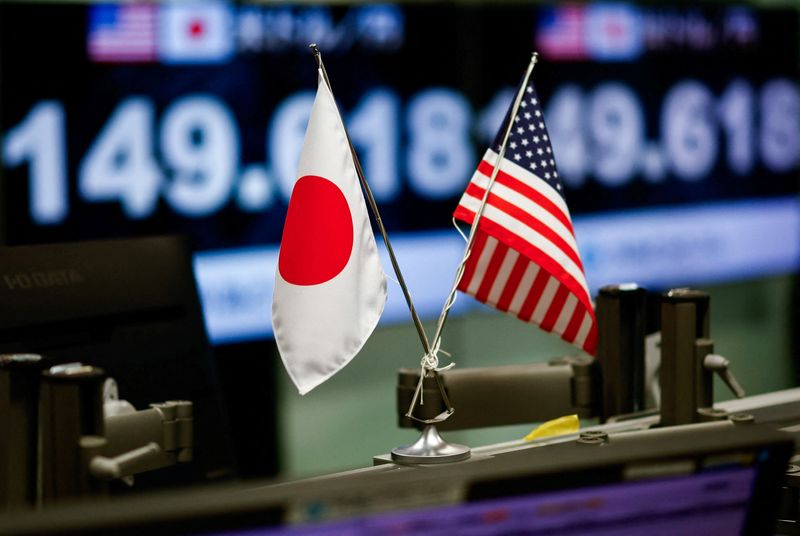TOKYO (Reuters) – Japan is suspected of making several currency market interventions this month to support the yen, underscoring unease over the pain the currency’s fall is causing households due to costlier imports.
While authorities have not confirmed whether they have intervened, the following explains Tokyo’s intervention tactics and what this move could mean for Japanese monetary policy:
WHY DID THEY GET IN?
The yen had fallen to a 38-year low of more than 160 per dollar before the likely intervention period, raising policymakers’ growing concerns that higher import costs could hurt weak private consumption.
The weak yen is already taking a toll on Prime Minister Fumio Kishida’s approval ratings ahead of the ruling party’s leadership race expected in September.
Left unattended, the yen’s decline would have risked giving markets the impression that Tokyo was turning a blind eye to speculative moves that were out of line with fundamentals.
WHAT IS DIFFERENT THIS TIME?
Unlike previous intervention periods that typically took place amid sharp declines in the yen, the likely intervention on July 11 took place when the dollar was already falling in response to weak US inflation data.
This suggests that Tokyo was trying to seize the moment when the market tide was already turning in favor of the yen. Rising prospects of a US rate cut in the near term would also allow Japan to argue that a further decline in the yen against the dollar does not reflect fundamentals and warrants intervention.
Some analysts say the change in tactics may have been aimed at keeping markets in the dark about when authorities might intervene again. Top currency diplomat Masato Kanda said there is no fixed period within which to judge whether the yen’s moves are excessive.
A media report that Japan was implementing interest rate controls against the euro/yen also spooked markets as it is rare for Tokyo to intervene against the single European currency.
WHERE IS THE LINE IN THE SAND?
Authorities say they have no specific levels in mind. But traders estimate that 160 yen per dollar is Japan’s line in the sand, raising the likelihood of intervention.
For example, Tokyo spent 9.8 trillion yen ($62.7 billion) on currency market interventions in late April and early May after the Japanese currency hit a 34-year low of 160.245 per dollar on April 29.
The yen has since fallen to a 38-year low of 161.96 per dollar on July 3, before last week’s suspected intervention period pushed it back below the 160 line.
WHAT ELSE CAN CAUSE INTERVENTION?
Rising import costs due to a weak yen threaten to derail the government’s efforts to turn inflation-adjusted wage growth positive and give households more purchasing power.
If public anger grows over the inflationary impact of a weak yen, it could increase political pressure on authorities to intervene again and halt the currency’s declines.
WILL TACTICS CHANGE UNDER NEW LEADERSHIP?
Incumbent top currency diplomat Masato Kanda, who led massive yen buying interventions in 2022 and 2024, is known to be aggressively warning markets against pushing the yen down.
Kanda will see his term end in July and will be succeeded by Atsushi Mimura, a financial regulatory veteran whose views on currency policy are little known.
Japan’s exchange rate policy is likely to remain largely unchanged under a new currency chief. However, communication styles may differ as some diplomats tend to issue more explicit warnings to the markets than others.
HOW COULD THE LATEST INTERVENTION AFFECT BOJ POLICY?
Markets are divided over how Tokyo’s latest foray into the market could affect the Bank of Japan’s decision on whether to raise rates at its July 30-31 policy meeting.
The BOJ may feel under pressure to join the government’s efforts to slow the yen’s decline by delivering a double aggressive surprise in the form of quantitative tightening and a rate hike.
But this could give markets the impression that yen movements are a key driver of the interest rate decision. That’s something the BOJ wants to avoid, as it would violate central bank protocol not to use monetary policy as a tool to directly control currency movements.
If the latest intervention period succeeds in turning the yen’s weak tide, it could give the BOJ more flexibility in timing the next rate hike, analysts say.

In Japan, the Ministry of Finance decides whether to intervene in the foreign exchange market, with the central bank acting as agent.
($1 = 156.3200 yen)


